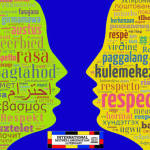 Learning and actively using a second language, whether done from childhood or later in life, can not only improve language processing but benefit the brain in a more general sense. In a study published in January of 2015 entitled Effects of Bilingualism on the White Matter Structure of the Brain, it was found that active bilinguals (those who regularly use both a first and second language) had higher fractional anisotropy values (structural differences) in white matter tracts that are linked to language processing.
Learning and actively using a second language, whether done from childhood or later in life, can not only improve language processing but benefit the brain in a more general sense. In a study published in January of 2015 entitled Effects of Bilingualism on the White Matter Structure of the Brain, it was found that active bilinguals (those who regularly use both a first and second language) had higher fractional anisotropy values (structural differences) in white matter tracts that are linked to language processing.
Bilingualism Benefits the Brain at Any Age
Celebrate International Mother Language Day
Inclusive Education through and with Language – Language Matters
Message from the Director-General of UNESCO, Irina Bokova:
 2015 marks the 15th anniversary of International Mother Language Day – this is also a turning point year for the international community, as the deadline for the Millennium Development Goals, when countries will define a new global sustainable development agenda.
2015 marks the 15th anniversary of International Mother Language Day – this is also a turning point year for the international community, as the deadline for the Millennium Development Goals, when countries will define a new global sustainable development agenda.
The focus for the post-2015 agenda must fall on the priority of advancing quality education for all — widening access, ensuring equality and inclusiveness, and promoting education for global citizenship and sustainable development. Education in the mother language is an essential part of achieving these goals — to facilitate learning and to bolster skills in reading, writing and mathematics. Taking this forward requires a sharper focus on teaching training, revisions of academic programs and the creation of suitable learning environments.
UNESCO takes forward these goals across the world. In Latin America, with the United Nations Children’s Fund, UNESCO is promoting inclusive education through bilingual intercultural approaches, in order to include both native and non-native cultures. For the same reasons, the UNESCO Regional Bureau for Education in Asia and the Pacific, based in Bangkok, Thailand, is working to deepen understandings of multilingual education based on the mother tongue, across the region and further afield. Mother tongue education is force for quality learning – it is also essential to bolster multilingualism and respect for linguistic and cultural diversity in societies that are transforming quickly.
Since 2000, there has been tremendous progress to reach the goals of Education for All. Today, we must look ahead – to complete unfinished business and to tackle new challenges. International Mother Language Day is a moment for all of us to raise the flag for the importance of mother tongue to all educational efforts, to enhance the quality of learning and to reach the unreached. Every girl and boy, every woman and man must have the tools to participate fully in the lives of their societies – this is a basic human right and it is a force for the sustainability of all development.
Language education counts
For UNESCO, “appropriate language education” is fundamental to enable learners to benefit from quality education, learn throughout life, and have access to information. This is possible if there is an approach to language education that promotes the use of at least three languages: one of which should be a mother tongue or first language (c.f.: the standard set by UNESCO in its position paper, Education in a Multilingual World).
Language education can also be seen as a means to ensure that, down the road, learners participate as global citizens, acting for change at both the local and global levels.
The presentations and discussions foreseen on the occasion of IMLD 2015 will seek to demonstrate that quality language education (and multilingual education in particular) is an effective means to ensure inclusion in and through education and build global citizens. If undertaken appropriately, it can equip learners with the language skills they need to contribute proactively to society, creating a more peaceful, inclusive and sustainable world. Language education also offers a framework for transmitting values and knowledge that strengthen a sense of belonging to both local and global communities, which are the starting point of civic engagement.
But much remains to be done to make sure language education does generate such returns. During the celebration of Mother Language Day 2015, we will review the challenges to the implementation of “appropriate language education” and highlight examples of good practices in this area, which can inspire Member States and partners to support its development and use.
New Tablet-Based Interactive ELL Test
This fall, Pearson is launching TELL (Test of English Language Learning), a tablet-based assessment developed to help schools assess progress of English Language Learners (ELLs). TELL will employ one of the most tried and tested automated scoring technologies to give teachers quick access to the information they need to inform instruction, while providing district leaders with the data they need to meet state and federal reporting requirements.
“English language learners are the fastest growing student population in the U.S. and 60% of those students are in elementary school. When we talked to school and district assessment directors as well as English language teaching specialists from around the country, they emphasized the critical need for a new and engaging approach to measuring English language proficiency that accurately diagnoses students’ needs and monitors their progress,” said Alistair Van Moere, Ph.D., head of Pearson’s Assessment Product Solutions.
TELL is an interactive assessment. Students watch video clips and interact with pictures and words, then answer questions out loud. They listen, write, read, and speak — all with no mark-ups or grading by teachers. TELL screens, diagnoses, and monitors each ELL student’s progress throughout the school year.
Student responses — written and spoken — are automatically scored by Pearson’s automated scoring technologies, providing teachers with access to results within minutes. Over the past 15 years, Pearson’s spoken and written language assessment technologies have scored millions of responses and are supported by research studies that demonstrate that they score as accurately as an expert human grader.
Pearson senior product manager Paula Hidalgo, Ph.D., said, “We leveraged the power of our research-based automated scoring technologies combined with the interactivity of the tablet environment to develop a tool to measure students’ English language proficiency at key points during the school year in a flexible, reliable, and consistent way.”
The test can be used with just one student at a time, a small to large group, or for whole-class administration at the school or district level. The assessment is aligned to today’s rigorous standards.
www.PearsonAssessments.com/TELL
Less is More?
Kristal Bivona details the MLA’s new report on world language enrollments
 The Modern Language Association (MLA) published a new report on the state of language education at the post-secondary level. The report, Enrollments in Languages Other than English in United States Institutions of Higher Education, covers enrollments in 2013 at 2,696 institutions. The MLA’s has gathered and analyzed data on world language enrollments since 1958, with recent reports showing enrollments in 2009, 2006, and 2002. This year’s findings are a mixture of good news and bad news for language departments at U.S. colleges and universities: enrollments in world languages decreased by 6.9% from 2009 to 2013. Despite this, enrollments in advanced courses increased for many languages, meaning that although fewer students are enrolling in language courses overall, more students are continuing their language education and becoming more proficient.
The Modern Language Association (MLA) published a new report on the state of language education at the post-secondary level. The report, Enrollments in Languages Other than English in United States Institutions of Higher Education, covers enrollments in 2013 at 2,696 institutions. The MLA’s has gathered and analyzed data on world language enrollments since 1958, with recent reports showing enrollments in 2009, 2006, and 2002. This year’s findings are a mixture of good news and bad news for language departments at U.S. colleges and universities: enrollments in world languages decreased by 6.9% from 2009 to 2013. Despite this, enrollments in advanced courses increased for many languages, meaning that although fewer students are enrolling in language courses overall, more students are continuing their language education and becoming more proficient.
Toolkit for Schools to Help Undocumented Students
The Dream Educational Empowerment Program (DEEP) has released a 65-page National Institutions Coming Out Day Toolkit in preparation for the National Institutions Coming Out Day (NICOD) on April 7, 2015.
This toolkit, the first of its kind, equips students and educators with materials and resources to facilitate institutions’ participation. It lists 29 clear and concrete examples of institutional efforts to increase resources and support systems for undocumented students nationwide.
Angela Chaun-Ru Chen, director of the Undocumented Student Program at the University of California at Los Angeles issued the following statement, “In working with undocumented students and educator allies, I have learned that institutional resources can be scarce and isolated. Having access to this toolkit can facilitate a starting point for educators seeking to design programs and institutional efforts that advance the well-being of these students.”
Laura Bohorquez, Dream Educational Empowerment Program coordinator added, “Understanding that each institution has different levels of capacity to implement change is critical. Our toolkit gives all institutions options that have proven successful across the nation.”
By incorporating the current context of education policies, like in-state tuition and Deferred Action for Childhood Arrivals, the toolkit is not only informative for educators but also practical in its ability to tailor commitment to institutional goals. The toolkit also fields questions to students and educators that foster ongoing dialogue within and among public and private institutions of higher education.
Grecia Rivas, a leader at ScholarshipsA-Z, a United We Dream affiliate said, “being able to share examples of varying commitment with the administration of my institution is an invaluable tool to start and spearhead solutions that address undocumented students on my campus.”
Relevance of Rights for All
Ayanna Cooper incorporates social justice into the Common Core for English learners
To date, 43 states, the District of Columbia, four territories, and the Department of Defense Education Activity (DoDEA) have adopted the Common Core State Standards (CCSS, 2015). Educators at all levels are working to ensure full and thorough implementation of these standards, which offer the opportunity to self-assess and revise initial instructional goals with a focus on improving outcomes for all students but especially those identified as English learners (ELs). The adoption of CCSS has undoubtedly fuelled the conversation as to how to address culturally and linguistically diverse learners in light of the rigorous standards. As a language educator, I am excited that the CCSS bring forth the need for all domains of language — speaking, writing, reading, and listening — to be emphasized and a permanent part of instructional practice; hence, all teachers are language teachers.
To read the full story, click here.
Feds Remind Educators of ELL Obligations
 The U.S. Departments of Education (ED) and Justice (DOJ) have released joint guidance reminding states, school districts, and schools of their obligations under federal law to ensure that English language learner (ELL) students have equal access to a high-quality education and the opportunity to achieve their full academic potential.
The U.S. Departments of Education (ED) and Justice (DOJ) have released joint guidance reminding states, school districts, and schools of their obligations under federal law to ensure that English language learner (ELL) students have equal access to a high-quality education and the opportunity to achieve their full academic potential.
“Four decades ago, the U.S. Supreme Court held in Lau v. Nichols that all students deserve equal access to a high-quality education regardless of their language background or how well they know English,” said ED assistant secretary for civil rights Catherine E. Lhamon.
Chimps Learn the Local Language
 When humans move to a new place, they oftentimes learn the local way of speaking, whether picking up some of the local language or just learning new vocabulary within the same language — think of a Londoner moving to California and calling the trunk of a car the boot or the hood of a car the bonnet. Ever since Saussurrean semiotics, it’s a common theory that words are arbitrary, and that whether you call it an apple, or a manzana or a pomme, these arbitrary words all refer to the same fruit. Humans adapt their language to be understood. However, a new study out in Current Biology suggests that we’re not the only ones. Chimpanzees also adapt their language when they move to a new place.
When humans move to a new place, they oftentimes learn the local way of speaking, whether picking up some of the local language or just learning new vocabulary within the same language — think of a Londoner moving to California and calling the trunk of a car the boot or the hood of a car the bonnet. Ever since Saussurrean semiotics, it’s a common theory that words are arbitrary, and that whether you call it an apple, or a manzana or a pomme, these arbitrary words all refer to the same fruit. Humans adapt their language to be understood. However, a new study out in Current Biology suggests that we’re not the only ones. Chimpanzees also adapt their language when they move to a new place.
New Federal Language Education Survey
 With funding from The Language Flagship at the Defense Language and National Security Education Office (DLNSEO), the American Councils Research Center (ARC), the research arm of American Councils, is overseeing the Comprehensive Survey of U.S. Foreign Language Enrollments: K-12 and Higher Education Project with the assistance of the Modern Language Association (MLA), the Center for Applied Linguistics (CAL), and American Council on the Teaching of Foreign Languages (ACTFL).
With funding from The Language Flagship at the Defense Language and National Security Education Office (DLNSEO), the American Councils Research Center (ARC), the research arm of American Councils, is overseeing the Comprehensive Survey of U.S. Foreign Language Enrollments: K-12 and Higher Education Project with the assistance of the Modern Language Association (MLA), the Center for Applied Linguistics (CAL), and American Council on the Teaching of Foreign Languages (ACTFL).




